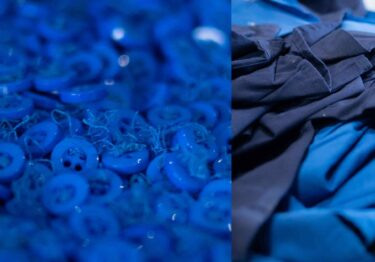I look at a set of scrubs in hospital and I think, wow.
These are just the beginning of a multi loop circular materials flow.
Local grown cotton, fully made here, super high quality so they last a really long time and they’re really comfortable to wear; not shedding any plastic microfibers, and they just last.
Then eventually they are feedstock for another garment.
They become the polo shirts, in schools, healthcare, aged & community care, those teams of amazing people that go out and care after others in their homes;and when those get tired…..
We take them back again, they’re still 100% natural fibre.
We bio refine them, yes that incredible pure cellulose can make the fibre that’s in so many health consumables, the hygiene wipes, swabs, incontinence pads, tubigrip, absorbent pads, bandaids.
Our care essentials; we taxpayers, have to buy them anyway, in their millions. Pads, swabs & sanitary items, they’ve been made so every part is also fully biodegradable or compostable, or even, just much safer to incinerate, a marvel of biofilms and biorefining.
We now have a single use health waste stream that is fully compostable
– ‘they’ said we couldn’t do it.
We displaced so much icky and awkward landfill and captured the nutrients, carbon and resources instead.
We’ve closed the loop.
That cycle we used before plastic, we’ve switched it on again – big time, and where we are still transitioning from synthetics, those that we do use are high quality with a very long life, we’ve stopped the churn.
What’s more it’s all our kids know! They know landfill, but that legacy we’ve left them is something we are now barely adding to.
We now have an amazing collaboration between the cotton, wool, timber and cane growing industries. We’ve partnered with some indigenous experts & researchers, selecting and farming the native plants with fantastic feedstock properties for these feed new biorefineries. They use virgin cellulose, agricultural waste, and reclaimed plant based textile feedstocks – not just for ourselves but export – yes export!
That global demand for renewable and recycled content just kept on growing and we responded.
It’s all renewably powered, part of directly regenerative agricultural systems, drawing down carbon – and people are fairly employed too. (seriously – this is how it works now!)
We keep track of it all thanks to an incredible combination of science and technology, remote and satellite monitoring as well as forensic fibre due diligence and automation in processing, even irrigation water allocations are on blockchain.
Who would have thought when we’d stepped into this decade, we’d come out leading in the field of sustainable and regenerative textile and apparel materials systems? Drawing down carbon to boot.
Now we are licencing our knowledge and systems around the world, robot assisted sorting waste fibres, closed loop processing, trace element authentication.
We made it easy to choose balance, no time poor parent has to sift the fine print at the super market, there’s no ethical shopping guide, as we no longer need it.
Of course energy is needed, of course there is give and take in the system, but here’s where the tech came in, we had to keep track of it, the inputs and the outputs, we don’t just hope it’s all working, we know it.
We made it so that the whole system was valued and that it was impossible to compete if your profit came from leaving a legacy of waste and permanent pollution, yes the waste drones pick up a few laggards now and again, but in this huge and stunning land, just as we’ve tracked illegal logging, we’ve stopped the dumping too; a synergy of indigenous & regional expertise enhanced by smart use of tech, drones and satellites.
Now you may wonder about international trade, this, of course is thriving, however now, instead of the inbalance and exploitation of the old school cheap labour and pollution based systems we’ve seriously brought about some justice. When we import products, whoever we work with and wherever they are their systems and processes would pass muster here too. That’s why we can compete, no more unfair employment, no more dead rivers or rapacious land clearing.
Technically it was simple, but culturally it was huge; we changed how we used finance & regulation, value for money took on a whole new meaning, and unleashed a revival of creativity, community and technical collaboration.
It started with some pilots, in 2022, combining waste, manufacturing, and public and private procurement. It took courage, now this scenario is just one example of a thriving creative and inclusive industrial design & manufacturing sector.
Every technical use and process of fibres and textiles, and renewable energy I’ve just described exists commercially now, and the level of automation is vast and growing. We just need to choose to use it.
So what will we need to do this? Apart from tenacity, determination, vision, and of course, the will.

And – most critically
We will get nowhere if we put all this effort into making things ethically, net zero, traced for authenticity etc if the items aren’t actually desirable, fit for purpose and needed.
It sounds like a cast of thousands….. yet in this room today, here in Brisbane; every single area of expertise I’ve just listed is represented among us.
I finish with one last key concept:
There’s no re-manufacturing without manufacturing.
Circular Economy and Manufacturing strategy, policy and regulation are inextricably linked.
We are going to be recovering from the pandemic, so I quote the economist famous for the post war recovery; John Maynard Keynes:
“Anything we can actually do, we can afford “
30 November 2021
In a workshop of around just 35 people from industry, academia, government and social enterprise.
| Powered by WordPress | Theme by TheBootstrapThemes